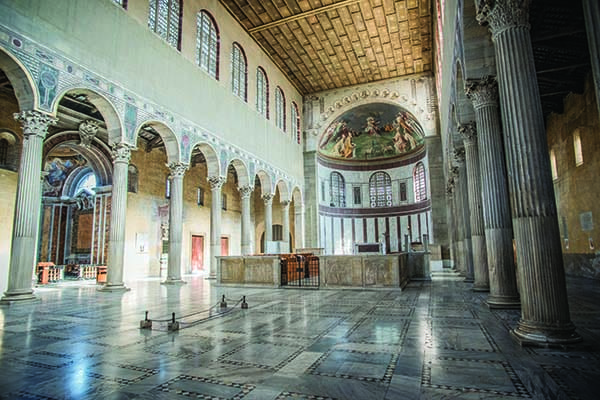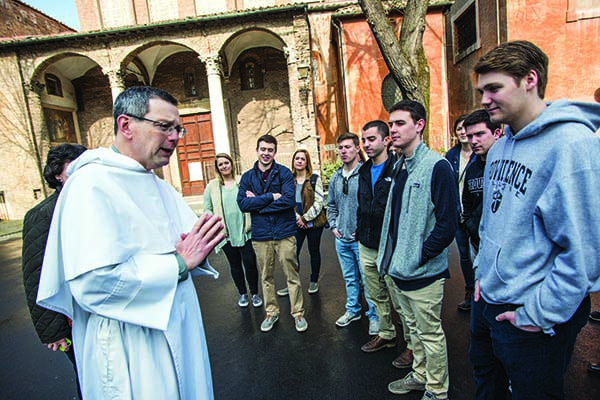April 14, 2016
St. Dominic prayed here

By Vicki-Ann Downing
In the convent at Santa Sabina, Providence College students bowed their heads and prayed in a small chapel — the room where St. Dominic lived in the 13th century.
Santa Sabina is the worldwide headquarters of the Order of Preachers, better known as the Dominicans, who founded Providence College almost a century ago and are celebrating their 800th anniversary this year.
Rev. Michael A. Mascari, O.P., a former PC trustee who serves on the General Council of the Order and holds the title of socius for the intellectual life, provided a lesson in art, architecture, and history for the visiting students from PC’s Center for Theology and Religious Studies.
“Dominicans come from all over the world to pray and to be in the same room where Dominic lived,” said Father Mascari. “There are books in many languages of the world for the celebration of Mass.”
Santa Sabina, built between 422-432, stands on the Aventine Hill, one of the Seven Hills of Rome. It is named for Sabina, an affluent Roman woman who lived on the site in the 2nd century and who was converted to Christianity by her slave, Seraphia. Both women were put to death as punishment afterward, Father Mascari said.
“It reminds us that Christianity, in the beginning, attracted the poor — people who were slaves, those without status and position,” said Father Mascari. “The message of Jesus was attractive to the lower classes, those on the fringe of the Roman world.”
Santa Sabina is one of the oldest churches in Rome, Father Mascari said. By 422, Christianity had been in existence for several hundred years, but churches were not built until Constantine legalized the religion in 313. The early Christian churches were modeled on the secular Roman basilica, a public building with an open meeting hall for gatherings.

Santa Sabina “looks the way a 4th century basilica looked,” said Father Mascari. “It’s why art historians and historians from around the world generally come. This basilica is not in ruins, like secular basilicas in the Forum. This basilica stands.”
Father Mascari pointed to a panel in a dark cypress door — believed to be the oldest known depiction of Jesus at the crucifixion. The students learned about it during a lecture by Dr. Aurelie A. Hagstrom ’85, associate professor of theology at PC and the faculty resident director in Rome. In St. Paul’s First Letter to the Corinthians, he preached the wisdom of Christ crucified — a “stumbling block” for those who knew the cross as an instrument of terror.
“Until Constantine, crucifixion was a form of punishment for the worst crimes,” Father Mascari explained. “It was an extremely horrible kind of death, with terrible suffering. No one would want to celebrate crucifixion. For St. Paul to write, ‘I preach Christ crucified,’ and ‘I have been crucified with Christ’ — the thought was horrifying. St. Paul really turned the tables on our understanding of what the cross is.”
Pope Honorius III, who approved the Order of Preachers in 1216, gave Santa Sabina to St. Dominic in 1219. At that time, it was “not an ideal piece of real estate,” Father Mascari said. Rome’s population had shrunk. The city was “a lot like Detroit,” abandoned and on hard times.
A spot on the floor of the church marks the place where the Dominicans would see their founder in prayer, prostrate on the stone.
Other famous Dominicans who have resided at Santa Sabina are St. Albert the Great, St. Thomas Aquinas, and Pope St. Pius V. Today, about 30 Dominican administrators live there, including the master of the order, Most Rev. Bruno Cadoré, O.P., and Very Rev. D. Dominic Izzo, O.P. ’88 & ’05Hon., socius for the Dominican provinces in the United States and former prior provincial of the Province of St. Joseph, which includes PC.
“We sing psalms, the Divine Office, to each other every morning and every evening here,” Father Mascari said. “We pray here every day. We pray in Italian.”





